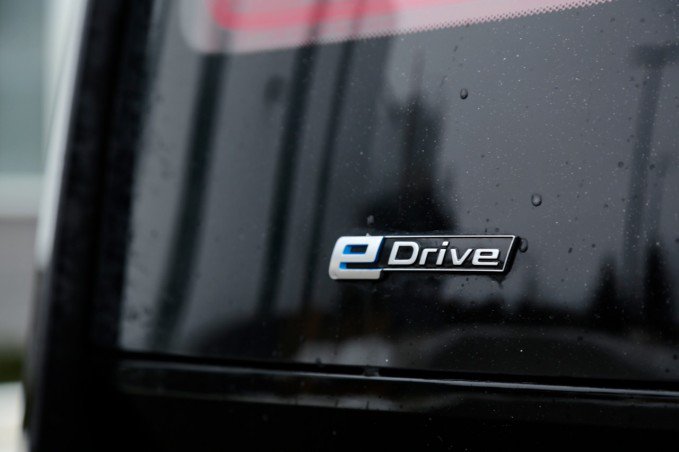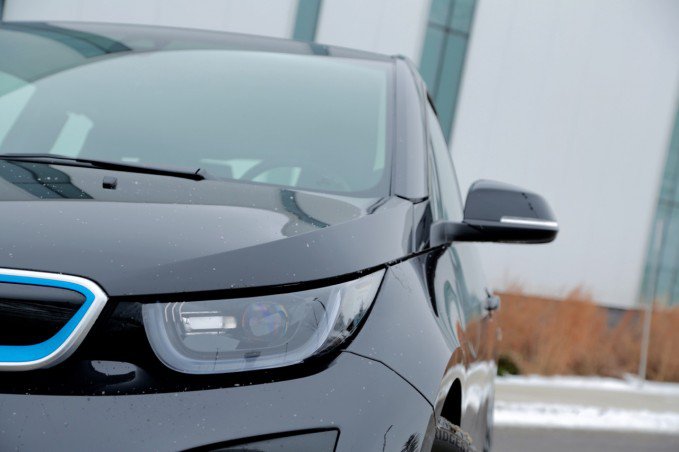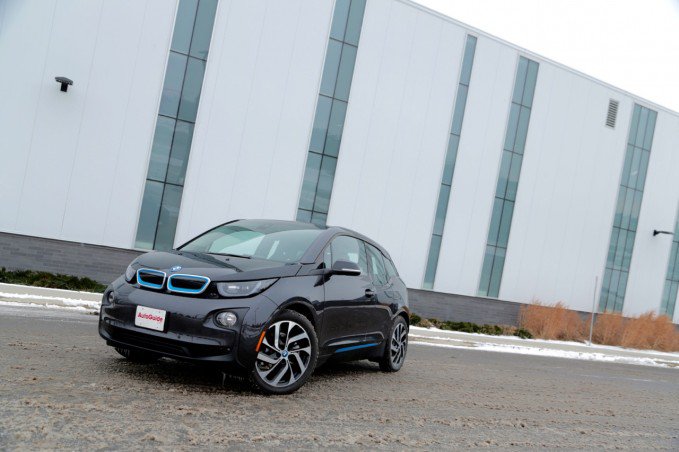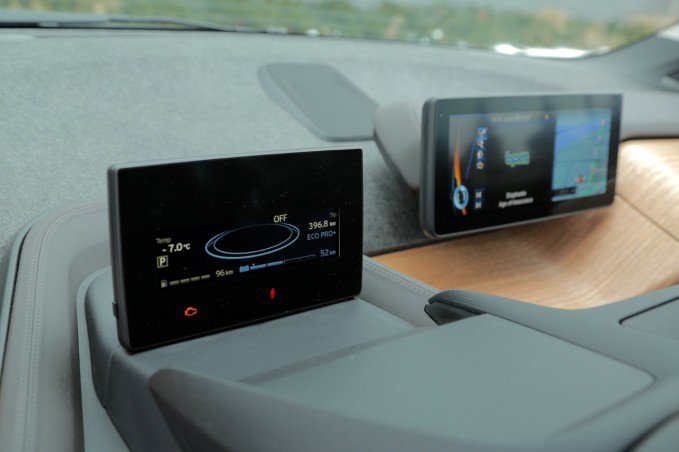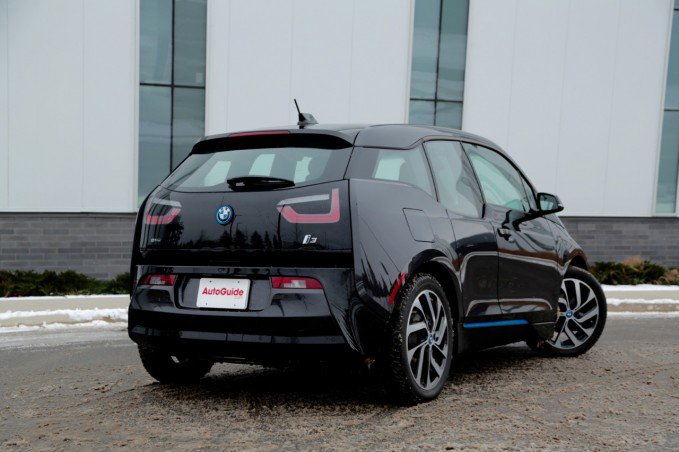What does the future hold?
Lacking a reliable time machine, all we can do is speculate. Maybe the Cleveland Browns win the Super Bowl. Maybe Miley Cyrus will run for office and maybe, just maybe, everyone will be driving cars like the BMW i3.
The i3 is part of BMW’s i sub-brand that specializes in plug-in vehicles. As can be seen with its space-age styling, it incorporates a lot of outside-of-box thinking. At 157.8 inches long, it’s shorter than the Chevrolet Sonic hatchback, but taller than a Nissan Juke.
One or Two Powerplants?
The seating position inside the i3 is high, as the car’s passenger compartment sits on top of the 22-kWh, 450-pound lithium-ion battery pack. It sends power to a rear-mounted electric motor producing 170 hp and 184 lb-ft of torque. As equipped, BMW claims the car is capable of traveling 81 miles on a single charge.
Get the Flash Player to see this player.
Those looking for a bit more range will want to opt for the i3 REx that includes a range-extending gasoline engine. Measuring a whopping 0.6-liters, the two-cylinder engine puts out 38 hp and 41 lb-ft of torque. That may not sound like a lot of power, but the gas engine is only intended to create enough electricity to keep the i3’s electric motor running. Feeding the two-cylinder engine is a minuscule 1.9-gallon tank that recommends premium fuel.
Range and Acceleration
With the range extender engine installed, the i3 weighs just a bit more than 3,000 lbs. The extra weight shrinks the car’s all-electric range to just 72 miles, but overall range including the gasoline generator grows to an official figure of 150 miles.
That puts the i3 ahead of small electric vehicles in terms of range by a good amount, at least until the Chevrolet Bolt comes out. And unlike a lot of electric vehicles, the i3 is pretty quick, capable of running from zero to 60 mph in 7.0 seconds, or 7.8 seconds while carrying the range-extender engine. The car feels every bit capable of these times with great off-the-line grunt. But as velocity builds toward freeway speeds, acceleration noticeably begins to trail off.
Of course, overall range, acceleration and top speed can be altered depending on which of the i3’s three drive modes in engaged as EcoPro and EcoPro+ limit top speed and climate control usage for added range.
Drives Better than an EV, But Not a BMW
The i3 may have some of the strangest tires ever fitted onto a car. They are skinny, at only 155 mm wide, feature a high 70 aspect sidewall and are fitted to massive 19-inch wheels. Cars with range extender engines do get slightly wider 175 mm rear tires to handle the extra weight, but they’re still more motorcycle-like than car.
The i3 handles better than expected for car with tires skinnier than those found on a Mitsubishi Mirage or smart fortwo. It won’t hold up traffic on an on-ramp and can out maneuver other electric city cars like Mitsubishi i-MiEV and fortwo electric drive.
But BMW’s claim that the i3 still has the driving dynamics the brand is famous for is a bit of a stretch. The weight distribution is correct and acceleration is acceptable, but the steering response and cornering traction from these skinny tires are anything but sporty. The ride comfort is decent, but the i3 is susceptible to crosswinds, which is no surprise given its short wheelbase, tall body and narrow tires.
i3 in the Snow
I had the rare opportunity to evaluate the i3 in wintry, icy conditi
ons. Although it’s rear-wheel drive, a lot of the vehicle’s weight is centered over the rear tires, aiding in traction. But with the instant electric motor torque and narrow contact patches, the i3 can easily break the rear tires loose in slippery conditions, even with winter rubber installed.
SEE ALSO: BMW i3 Undergoes Evaluation with LA Police Department
The i3 can handle moderate snow if driven carefully, though, thanks to the programming of the stability control system. It works hard to keep the i3 pointed in the right direction and really makes driving the car easy. Best of all, after an extensive drive in 22-degree Fahrenheit weather on winter tires, my total driving range only fell to 115 miles.
When the battery runs out of juice, BMW claims it can recharge in three hours with a stage 2 charger that can be found through the extensive ChargeNow network. There are tens of thousands of recharge stations littered across North America.
Just as Funky Inside
Like the outside of the car, the i3’s interior is unique. It features a swarm of different sustainable and recycled materials that can best be described as funky. The dual floating screens may not be for everyone, but they do show all the proper information.
By having no engine or motor up front, the cabin really opens up. There’s a massive dashboard and ample legroom. I wouldn’t want to think what replacing that giant windshield would cost though.
The story in the back isn’t as good, as with only 31.9-inches of rear legroom, no adult will want to spend much time back there, but at least there’s a pair of suicide rear doors to help people get in and out of the back.
The Verdict: 2016 BMW i3 Review
Being a range-extending electric car, it’s easy to draw comparisons between the i3 and the Chevrolet Volt. But they are quite different. The Volt has a large, not-so-efficient gasoline engine that is intended to give the car similar range to conventional compacts. The i3 is more of an electric city car that can be had with a small generator to double range when needed.
The BMW is more of a pure, no-compromises, dedicated city electric vehicle like the i-MiEV, smart ED or Fiat 500e. At a starting price of $47,245 after destination charges, the i3 REx may be more expensive than those vehicles, but it’s packaged in a more usable, livable size. It also takes range anxiety away with its small generator engine that can be used in a pinch for longer trips – as long as you don’t mind stopping every 60 or so miles for a fill-up. Although not perfect, the i3 really might point to the future of urban motoring.
Discuss this story on our BMW Forum







